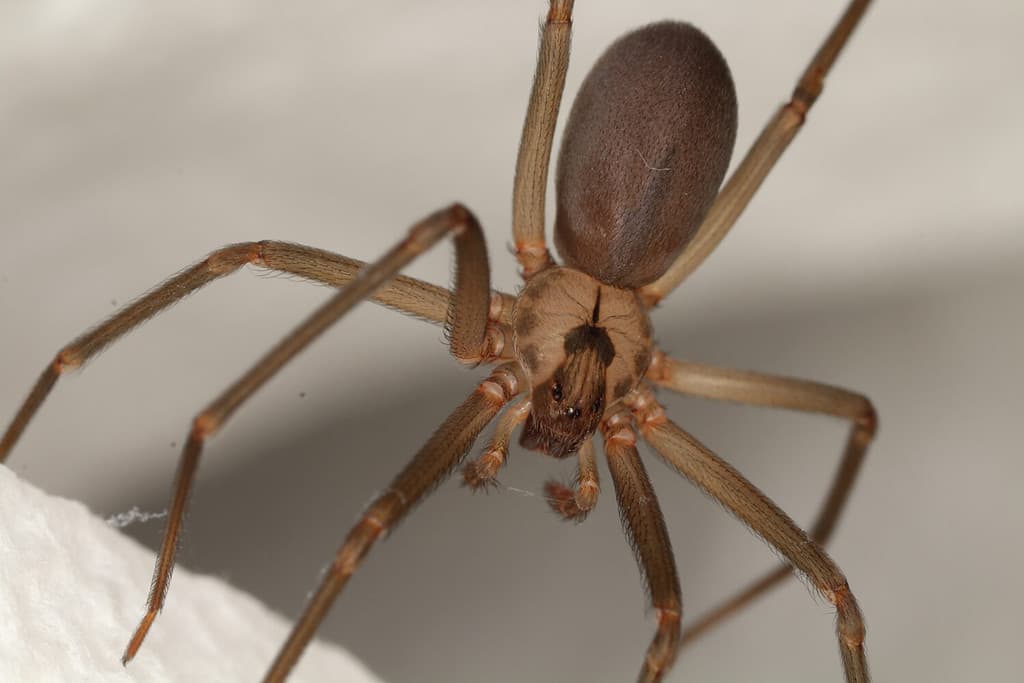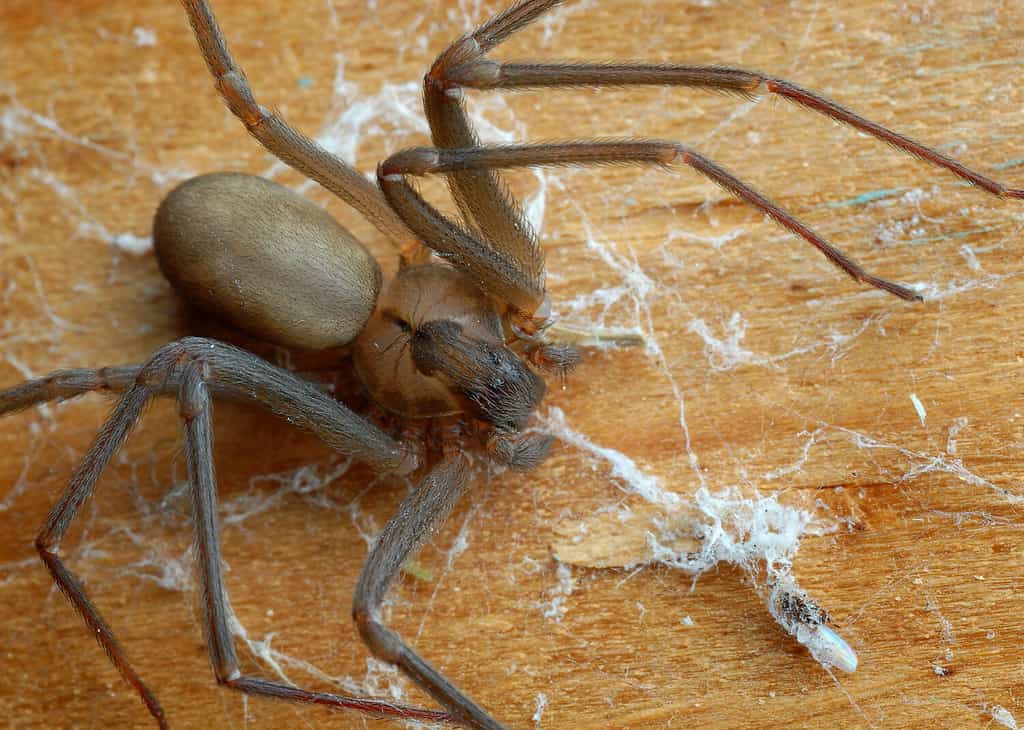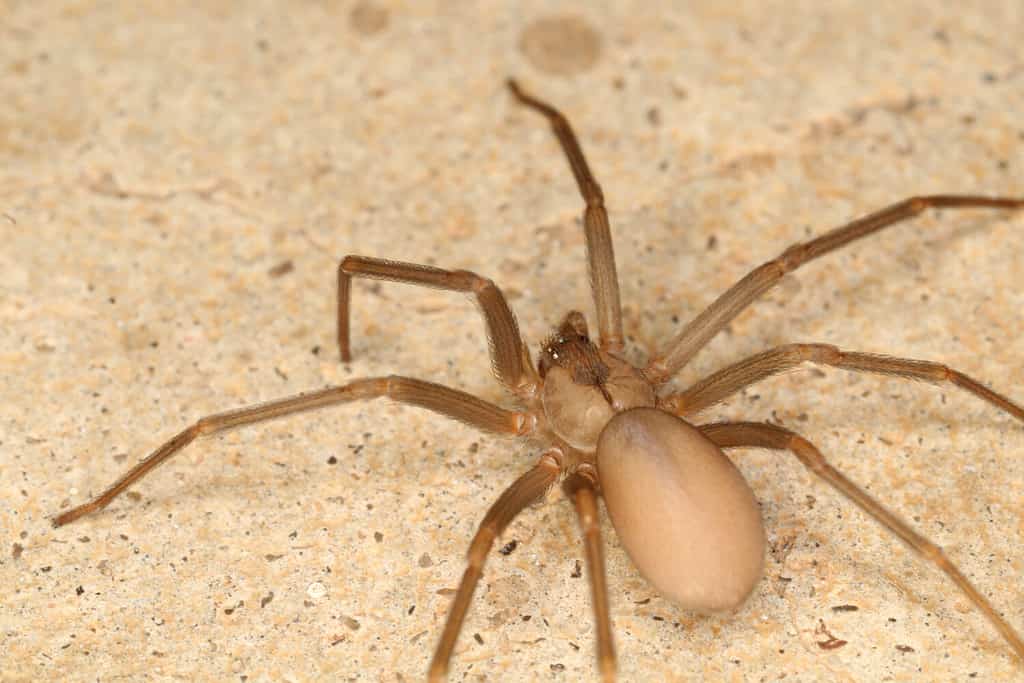The brown recluse (Loxosceles reclusa) is a species of violin spider from the Loxosceles genus and Sicariidae family. There are over 140 different species of recluse spiders, but the brown recluse is the most well-known.
These spiders are known for their painful bite and potent necrotic venom that can be fatal to humans. Brown recluse spiders are native to the Midwestern and south-central United States, namely Oklahoma, Texas, and Alabama. It is uncommon to find brown recluse spiders beyond their native habitats.
This comprehensive article covers the brown recluse spider’s appearance, habitat, venom, diet, and life expectancy.
Appearance: How To Identify a Brown Recluse Spider

You can recognize a brown recluse spider by the dark violin-shaped marking on their cephalothorax.
©Nick626/Shutterstock.com
Size
Identifying a brown recluse spider can be challenging because of their small size and resemblance to other species. Brown recluse spiders generally grow to the size of a United States quarter or around half an inch to 1 inch with extended legs. Females are larger than the males with a body size of 0.24 to 0.79 inches. Males have smaller bodies, but significantly longer legs when compared to their body.
Anatomy
Typical of other arachnids, brown recluse spiders have a total of eight legs attached to their cephalothorax (fore-body). Each of their thin legs is made up of seven segments – the femur, patella, tibia, metatarsus, and tarsus. Their six eyes, pedipalps, and chelicerae are also located on their cephalothorax.
Brown recluse spiders have brains and hearts, along with silk glands and spinnerets to create webs. They use a special respiration organ called a book lung to breathe oxygen. Mature males have enlarged pedipalps that function as a reproductive organ, whereas females lack those thickened pedipalps and have ovaries instead.
Color and Markings
The brown recluse spiders’ most distinctive feature is the dark violin-shaped marking on their cephalothorax. Their bodies are a tan to dark brown coloration with fine hairs and no patterns. Their coloration is uneven, so certain parts of their bodies are darker or lighter.
Brown Recluse Spider Location and Habitat

The brown recluse spider is established in approximately 16 states within the United States.
©Miles Boyer/Shutterstock.com
Brown recluse spiders can be found in the United States, with populations in Texas, Nebraska, Colorado, Arkansas, Missouri, and Oklahoma. It is highly unlikely to find brown recluse spiders outside of the United States in their established locations.
These spiders prefer a solitary lifestyle and inhabit both outdoor and indoor environments. You can find brown recluse spiders in the wild and commonly near human settlements as they can thrive in quiet areas of our homes.
They create their webs in dark and undisturbed areas like cellars, sheds, and garages. Brown recluse spiders will web up logs, bark, leaf litter, and rock piles outdoors. They create thin asymmetrical webs and spend most of their time hiding until they search for food. It is common for males to be more active, while the females remain on their webs.
Brown Recluse Spider Bite and Venom Level
Bites
Bites from these spiders are rare but dangerous to humans. Brown recluse spiders do not actively venture out to bite humans and only bite to defend themselves when threatened. You could get bitten when putting on clothes or shoes where they were hiding.
The initial bite from a brown recluse appears as a pale red blister and may change to a harsh purplish-blue color within the next 48 hours. Their bite usually causes a whiteish ring, and the surrounding skin might be inflamed. Although the bite isn’t painful or noticeable at first, it could become itchy and intensely sore. Not every brown recluse spider bite is medically significant, and some people have more severe reactions than others.
It is important to seek immediate medical attention if you suspect you have been bitten by a brown recluse spider.
Venom

Brown recluse spiders are venomous and not poisonous.
©Nick626/Shutterstock.com
Brown recluse spiders are notorious for their potent venom with cytotoxic and hemolytic properties. Their tiny fangs can puncture human skin and inject venom that may lead to necrosis of the surrounding tissue and skin. Various systemic signs can occur from their venomous bites, such as nausea and muscle pain.
A bite from a brown recluse spider can cause loxoscelism, a serious condition and the only known dermonecrotic arachnidism affecting humans. Several components are found in brown recluse spider venom, including hyaluronidase, which increases how quickly the infected cell membranes are penetrated.
The toxic enzyme known as sphingomyelinase D in brown recluse venom is responsible for the skin, tissue, and blood vessel (hemolysis) damage following a severe bite. Although the bite of a brown recluse can do a lot of harm, it rarely results in death.
What Do Brown Recluse Spiders Eat?
Brown recluse spiders are nocturnal and mostly hide during the day but leave the safety of their webs to hunt at night. Their diet consists of numerous insects that they prey on without using their webs. They actively hunt for flies, moths, other spiders, and crickets. However, they may also scavenge for insects that were recently killed. They kill their prey by injecting venom from their fangs and begin eating the insect once it dies.
How Long Do Brown Recluse Spiders Live For?
Brown recluse spiders have relatively short lifespans at around one to two years. Their eggs take about one month to hatch and 10 to 12 months for the spiderlings to reach maturity. Brown recluse spiders can only reproduce once they mature, and males may die shortly after.
In Summary
The brown recluse is an established species in parts of the United States where they inhabit dry, undisturbed areas. These spiders are identified by their brown bodies usually no larger than 1 inch. They are seriously venomous spiders that bite when they feel threatened, usually when trapped against the skin. Although their bite rarely causes death, enzymes in the venom can cause serious skin and tissue damage.
The photo featured at the top of this post is © TacioPhilip/iStock via Getty Images
Thank you for reading! Have some feedback for us? Contact the AZ Animals editorial team.







